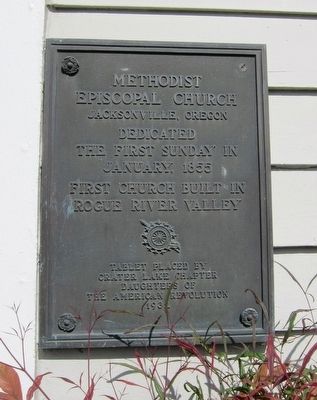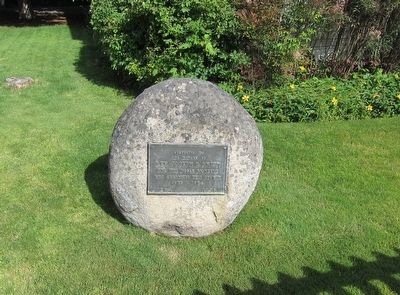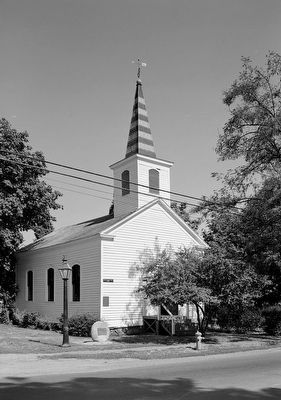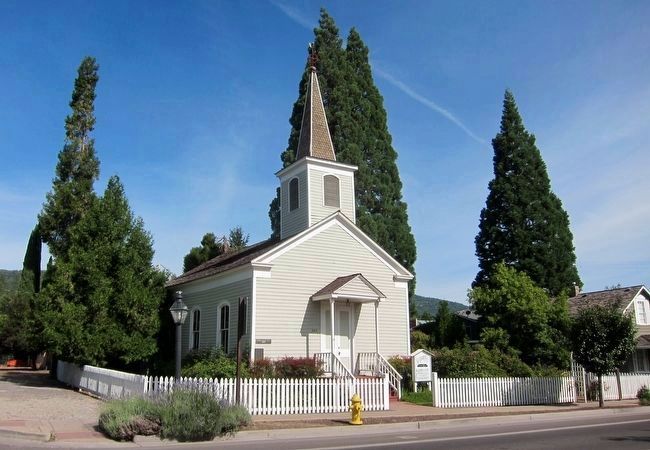Jacksonville in Jackson County, Oregon — The American West (Northwest)
Methodist Episcopal Church
Jacksonville, Oregon
the first Sunday in
January, 1855
First church built in
Rogue River Valley
Tablet placed by
Crater Lake Chapter
Daughters of
the American Revolution
1932
Erected 1932 by Crater Lake Chapter, Daughters of the American Revolution.
Topics and series. This historical marker is listed in this topic list: Churches & Religion. In addition, it is included in the Daughters of the American Revolution series list. A significant historical month for this entry is January 1855.
Location. 42° 18.91′ N, 122° 57.922′ W. Marker is in Jacksonville, Oregon, in Jackson County. Marker is at the intersection of North 5th Street and East D Street, on the left when traveling north on North 5th Street. Touch for map. Marker is at or near this postal address: 305 North 5th Street, Jacksonville OR 97530, United States of America. Touch for directions.
Other nearby markers. At least 8 other markers are within walking distance of this marker. Warren Lodge No. 10 (about 300 feet away, measured in a direct line); Catholic Rectory (about 300 feet away); Beekman Bank Well (about 700 feet away); History Right Here - Horse Powers (about 700 feet away); Rogue River Valley Railroad Depot (approx. 0.2 miles away); History of Local Telephone Service (approx. 0.2 miles away); Jacksonville’s Rogue River Valley Railway 1891-1925 (approx. 0.2 miles away); City Hall (approx. 0.2 miles away). Touch for a list and map of all markers in Jacksonville.
Also see . . .
1. A History of St. Andrew's Traditional Episcopal Church. Church website:
St. Andrews presents a history of the church: "What we now have at St. Andrew's is an inheritance from the past, for in the beginning it was the Methodist Church, who built the present building and carried on services of worship from the years 1853 until 1928. Here is their story: The spring of 1853 saw a large religious element arrive in Southern Oregon, largely from the Middle West. A section of this immigration came to be called the "Preachers Train" because of the large number of ministers it contained. In this immigration was the Reverend Joseph Smith, who became the first minister. Under his leadership erection of the Methodist Church began, but it was not finished until 1854, with Reverend Fletcher Royal as the pastor and guiding force. An interesting story is told that Fletcher Royal made a deal with the miners in a saloon located near the church to give their winnings to a building fund for the erection of the church. However, this is only a story
and doubtless others also contributed. It is worth noting that James Cluggage, who took the first gold out of Jacksonville, donated the lot. In 1854, two years after the discovery of gold on Daisy Creek in Jacksonville, the Methodist Church was completed by James McDonough and Thomas Pyle, who had a successful carpenter shop in town. The church was the first religious edifice in Jacksonville and believed to be the first church in Southern Oregon. An 1852 map of Jacksonville located the Methodist Church on the southwest corner of California and Third Street. Apparently it was partially constructed on that site 1853; but was removed to the spot where it now stands finished by Reverend Fletcher Royal. It was recorded that Mrs. Royal and a Mrs. Ovserbeck raised money for the building by going from gold camp to gold camp." (Submitted on December 22, 2015.)
2. Methodist Episcopal Church, Fifth & D Streets, Jacksonville, Jackson County, OR. The Historic American Buildings Survey record for the Methodist Episcopal Church. Includes several photos and a short history. (Submitted on December 22, 2015.)
Credits. This page was last revised on January 26, 2021. It was originally submitted on December 22, 2015, by Andrew Ruppenstein of Lamorinda, California. This page has been viewed 322 times since then and 17 times this year. Photos: 1, 2, 3, 4. submitted on December 22, 2015, by Andrew Ruppenstein of Lamorinda, California.



